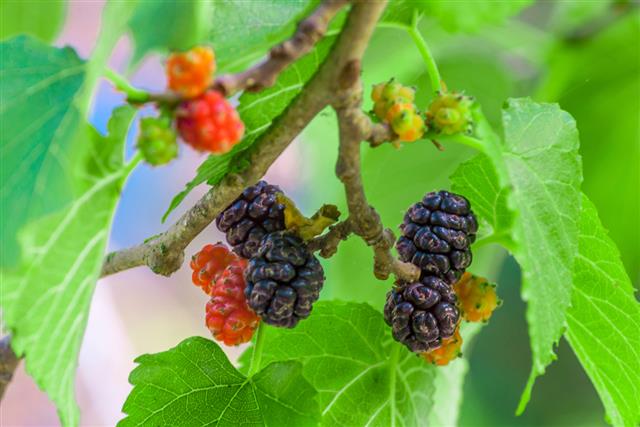
Trying to identify trees is a good way to get in touch with nature. In this article, we have given you tips to identify different types of mulberry trees, which is not as difficult as it sounds.
Native to the warm temperate and subtropical regions of Asia, America, Africa, and Europe, mulberry is a genus of 10-16 species of deciduous trees. The taxonomical name of this genus is Morus. Along with generic information, I have also listed some of the species to facilitate easy understanding about various types of mulberry trees.
Description
All the speciaes of mulberry are deciduous trees of varying sizes, around 30 to 85 feet in height. As young trees, they grow and establish themselves very quickly. But after a few years, the growth slows down drastically. The leaves of this tree are large, simple, alternately arranged, lobed, and serrated on the margin. Mulberry is grown for its fruit, and as each species bears fruit with distinct flavor and taste, it is used widely for making pies, tarts, wines, cake toppings, and cordials. It can also be eaten in the fresh or dried form. These trees are either dioecious (having the male and female reproductive organs on different trees) or monoecious (having the male and female reproductive organs on the same tree). When the new leaves develop in spring, the long male clusters and round female clusters of flowers are borne separately on small, slender, inconspicuous spikes. The female flowers are wind pollinated, except for some cultivars. The fruit borne by this tree, like raspberry, is an aggregate fruit and is made up of multiple single fruits. Once the flowers are pollinated, they begin to swell, and they come together upon maturity to resemble an individual drupe. The following are a few types of mulberry trees.
Red Mulberry
Botanically known as Morus rubra, the red mulberry tree usually grows up to 70 feet and can bear good fruit for 70-75 years, depending upon its condition. The leaves of this variety are often larger than those of the other species, blunt-toothed, and lobed. Their upper side is rough, while the underside is hairy. The fruits are usually deep red in color. The red mulberry is native to eastern USA.
White Mulberry
White mulberry is botanically known as Morus alba, and was introduced from its native land China in early colonial times for silkworm culture. The leaves of this tree are thin, glossy, and very light green (almost white, hence the name) in color. The leaves can be lobed or un-lobed. They bear sweet fruits in white, pink, or black color.
Chinese Mulberry
Native to China, this variety of mulberry is more of a large spreading shrub than a tree. It is scientifically known by the name Morus australis. It can grow up to 30 feet and spread 20 feet. Its branches are twisted and they bear large lustrous leaves. As a young plant, it needs plenty of care in terms of watering, fertilizing, and support staking. The fruits that this variety bears can be pink or purple in color. As it can add an interesting touch to the landscape, a few fruitless varieties in this species have been developed.
People who have basic knowledge of the plant kingdom can identify trees more easily as compared to others. Mulberry fruits, unlike other berries, can be enjoyed over a long period of time, as they ripen over an extended period. In most cases, the color of the fruit cannot be used to identify the type of tree. Mulberry trees can be trained and shaped to make them appear more bushy or like a small tree, and they look beautiful when in full bloom with red, white, pink, or black hanging on their branches.




